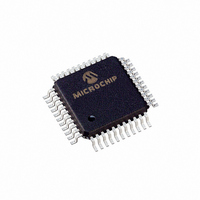PIC16C65B-04I/PQ Microchip Technology, PIC16C65B-04I/PQ Datasheet

PIC16C65B-04I/PQ
Specifications of PIC16C65B-04I/PQ
Available stocks
Related parts for PIC16C65B-04I/PQ
PIC16C65B-04I/PQ Summary of contents
Page 1
... This delay may not occur, and every valid clock edge will generate internal device clocks. OST OSC 3: CLKOUT is not available in these Oscillator modes but shown here for timing reference. 2003 Microchip Technology Inc. PIC16C63A/65B/73B/74B 2. Module: TMR1 When operating in External Clock mode (TMR1CS is set), reading either of the Timer1 registers (TMR1H or TMR1L) may cause the timer not to increment as expected ...
Page 2
... Internal while the SS pin is high, this will cause the Data Bus TRISC<5> bit to be set, thus disabling the Write SDO output. Shift Clock TMR2 Output 2 T Prescaler pin control enabled . DD from the TRISC<5> bit (see 2003 Microchip Technology Inc. ...
Page 3
... PACKAGE MARKING TEMPLATE FOR PIC16C63A AND PIC16C73B, 28-PIN QFN 28-Lead QFN XXXXXXXX XXXXXXXX YYWWNNN 2003 Microchip Technology Inc. PIC16C63A/65B/73B/74B 2. Table 3-1 of Section 3.0 (“Architectural Overview”) is replaced with an updated version that adds a column for QFN pin assignments. All new information is indicated in bold. ...
Page 4
... RC7 can also be the USART asynchronous receive or synchronous data. P — Ground reference for logic and I/O pins. P — Positive supply for logic and I/O pins. I/O = input/output P = power ST = Schmitt Trigger input (4) . (4) . (4) . (4) or the slave select for 2 C™ modes. 2003 Microchip Technology Inc. ...
Page 5
... Tie Bar Length Chamfer Mold Draft Angle Top *Controlling Parameter Notes: Dimensions D and E1 do not include mold flash or protrusions. Mold flash or protrusions shall not exceed .010" (0.254mm) per side. JEDEC equivalent: mMO-220 Drawing No. C04-114 2003 Microchip Technology Inc. PIC16C63A/65B/73B/74B EXPOSED METAL PADS ...
Page 6
... L .020 .022 .024 MILLIMETERS* MIN NOM MAX 28 0.65 BSC 0.80 0.90 1.00 0.00 0.02 0.05 5.90 6.00 6.10 3.55 3.70 3.85 5.90 6.00 6.10 3.55 3.70 3.85 0.23 0.28 0.33 0.50 0.55 0.60 2003 Microchip Technology Inc. ...
Page 7
... Figure 6. This circuit works by delaying the MCLR release following a power-up delay is required, the capacitor may be omitted. An alternative would be to use a supervisory circuit to control MCLR. Design validation should be performed to verify that the application works as expected. 2003 Microchip Technology Inc. PIC16C63A/65B/73B/74B FIGURE 6: MCLR EXTERNAL CIRCUIT ...
Page 8
... Under Clarifications/Corrections to the Data Sheet, all issues referenced pertain to Revision ‘C’ of the Data Sheet instead of Revision ‘A’. Rev C Document (8/2003) Added Data Sheet Clarification issue 2 (Packaging) and moved former silicon issue 1 (RESET) to Data Sheet Clarification section (now issue 3). DS80048C-page 8 2003 Microchip Technology Inc. ...
Page 9
... Serialized Quick Turn Programming (SQTP service mark of Microchip Technology Incorporated in the U.S.A. All other trademarks mentioned herein are property of their respective companies. © 2003, Microchip Technology Incorporated, Printed in the U.S.A., All Rights Reserved. Printed on recycled paper. Microchip received QS-9000 quality system ...
Page 10
... Via Quasimodo, 12 20025 Legnano (MI) Milan, Italy Tel: 39-0331-742611 Fax: 39-0331-466781 Netherlands Biesbosch 14 NL-5152 SC Drunen, Netherlands Tel: 31-416-690399 Fax: 31-416-690340 United Kingdom 505 Eskdale Road Winnersh Triangle Wokingham Berkshire, England RG41 5TU Tel: 44-118-921-5869 Fax: 44-118-921-5820 07/28/03 2003 Microchip Technology Inc. ...















